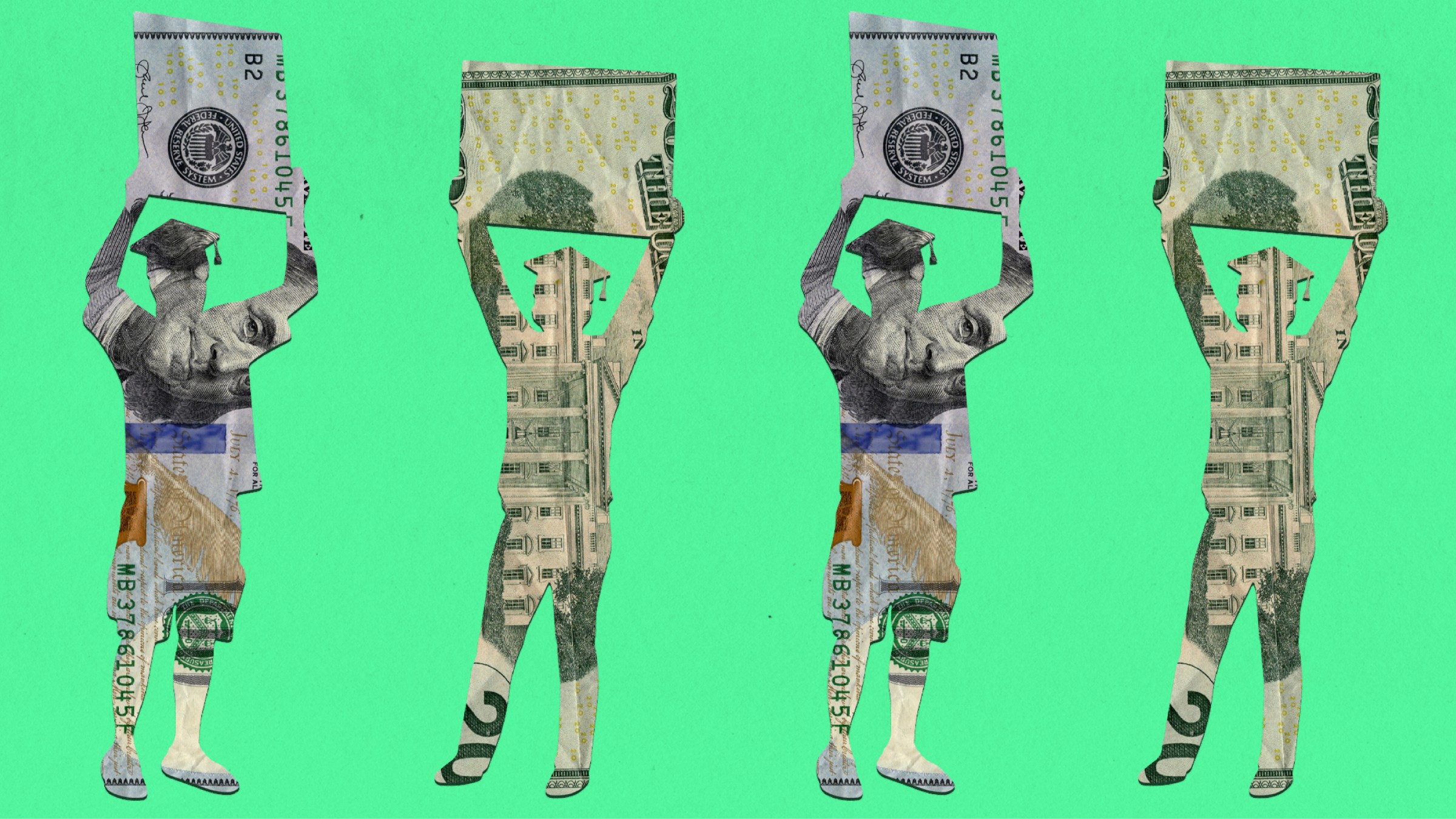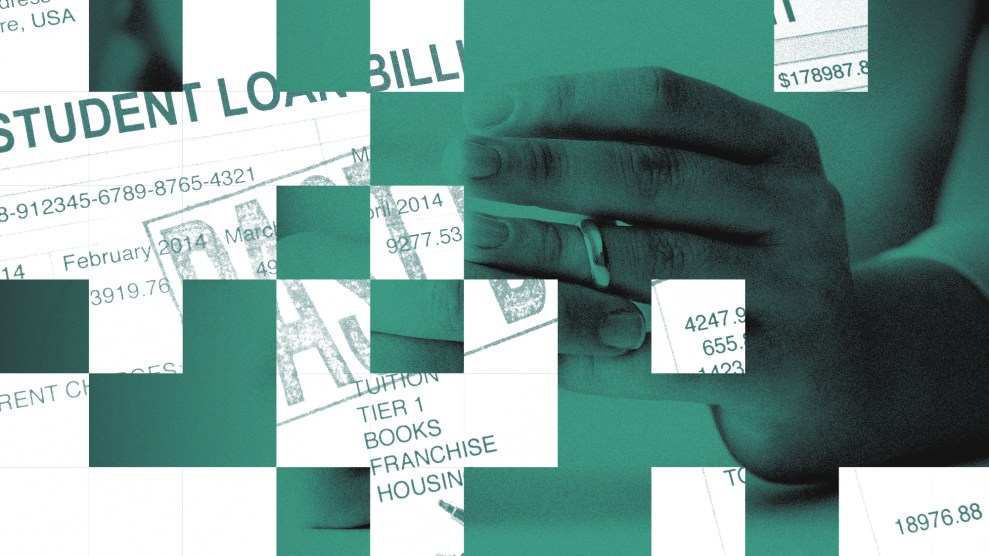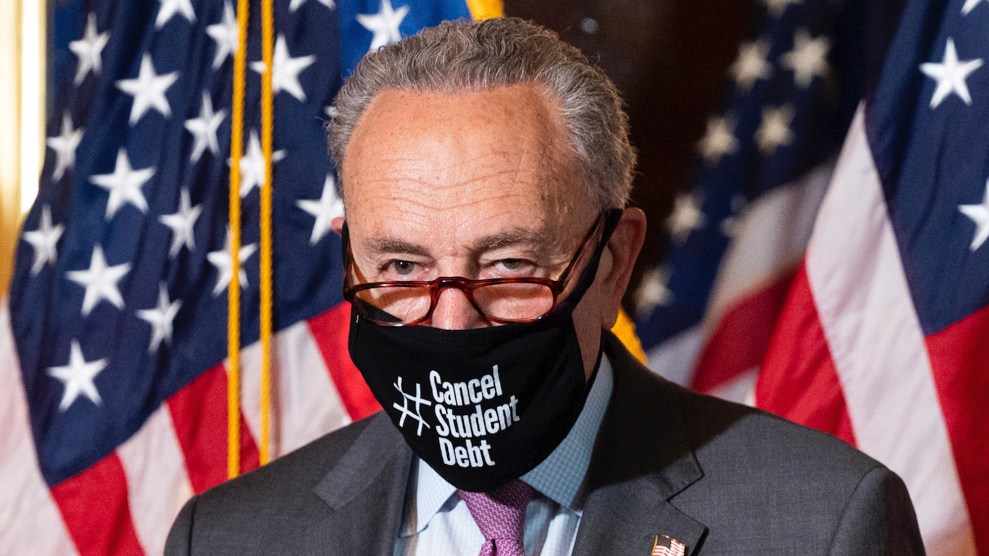As a 28-year-old art student, Thomas Gokey convinced the Federal Reserve to give him bags of shredded currency worth $49,983, the exact amount of his ballooning student loan debt. He had a plan to use the minced cash to make a work of art that would both symbolize his loans and help to pay them off: He pulped the scraps, turned the paste into four enormous sheets of paper, and began offering piecemeal sales—$4.22 a square inch.
In 2011, when the artwork was accepted by an annual competition in Michigan—“the American Idol of art,” as he describes it—that had been founded by the son of billionaire heir (and future Education Secretary) Betsy DeVos, Gokey saw another shot at paying off the debt. Up until then, he hadn’t found a lot of buyers willing to purchase bits of his loans, but he did start having conversations with people about their own debt, and about debt’s role in society. He’d also read anthropologist David Graeber’s new opus on the topic; Gokey found it “a secret decoder ring” unveiling how debt enshrines divides of gender, race, and class.
The week of the contest, Gokey weighed joining an upcoming protest against economic inequality that he’d heard was planned for a small park near Wall Street. But he trekked off to Michigan for the competition in hopes of chipping away at his loans, and convinced that whatever this protest was, it wouldn’t amount to much. He quickly regretted it. “I was still thinking of this as an individual problem,” he says. “Instead of joining the occupation from day one, like I should have done, I went to Betsy DeVos’ art fair and tried to sell my debt.”
His artwork, Total Amount of Money Rendered in Exchange for a Masters of Fine Arts Degree to the School of the Art Institute of Chicago, Pulped into Four Sheets of Paper, failed to win prizes or garner enough sales to make any real dent in Gokey’s debt. Within days, he and his sleeping bag were on a Greyhound bound for the Occupy Wall Street uprising.
In Zuccotti Park, Gokey started going to meetings where other protesters discussed making demands. To Gokey, that seemed off: Government and financial institutions would not capitulate merely out of kindness or shame. What power did the people in the park, or Americans at large, have to demand that these institutions do much of anything? Gokey started thinking about where they might find leverage: What was their closest point of cooperation with Wall Street and the government, and what would happen if they blew it up? Coming off his Hail Mary attempt to pay off his student loans, Gokey realized what that junction point was: debt. In the run-up to the Great Recession, Americans had accrued record amounts of household debt. And in just a decade, student debt had quintupled and was approaching $1 trillion. (Today it is at $1.75 trillion.) It was these financial ties to the institutions they’d come to protest that could give them bargaining power.
“It was like a switch flipped in my head,” Gokey says. “Our debt together actually gives us leverage. If we could organize something like a debtors’ union, we could force the government and Wall Street to do anything.”
Today, Gokey and six Occupy collaborators are the co-founders of the nation’s first debtors’ union, known as the Debt Collective—and they are closer than ever to proving themselves right. Over the last decade, their group has laid crucial organizing and legal groundwork that has helped shift the terms of debate around the idea of canceling student loans. They’ve helped to transform the concept from a fringe pipe dream into a near political inevitability, as the Biden administration is poised to take unprecedented action to cancel some or all of about 45 million Americans’ outstanding student loans. The latest White House plan, according to news reports, would forgive $10,000 per borrower.
“The idea that these debts aren’t carved in stone, which is what they feel like—changing that as a norm has to start somewhere, and they started it,” says Eileen Connor, a Debt Collective collaborator who directs litigation at Harvard Law School’s Project on Predatory Student Lending.
Occupy Wall Street was soon evicted from Zuccotti Park. But Gokey and other Occupiers who had engaged on the issue were undeterred: Soon, they returned to the park for a new protest, clad in faux graduation robes made of trash bags. “Hardly anyone cared,” remarked a dismissive Reuters correspondent on the scene. “They want all student debt in the country forgiven. All $1 trillion of it, if the government would be so kind.” But the budding union also began exploring something Graeber himself had raised on an internal Occupy listserv: Why not beat predatory financiers at their own game by buying up debt on the secondary market and—instead of using aggressive tactics to collect—simply cancel it?
Gokey began cold-calling brokers, asking to buy about $50 worth of unpaid debts, which are sold for pennies on the dollar. The brokers, used to cutting deals for tens of thousands of dollars, usually hung up. It took nine months, but eventually he found one who agreed to sell about $400 worth of credit card debt. Gokey scratched out a personal check; in return, he was emailed a spreadsheet with personal information on nine people: Social Security numbers, account numbers, and balances. Their $14,000 in debts were now Gokey’s to do with as he pleased.
Floored by this revelation, the activists launched the Rolling Jubilee project, named for the biblical tradition of a year when all debts are forgiven. Astra Taylor and Laura Hanna, co-founders of the collective and the owners of a company that produces films on philosophy and democracy, took the lead on organizing The People’s Bailout, a fundraising telethon featuring famous friends like comedian Janeane Garofalo and members of Fugazi and Sonic Youth. They hoped to raise $50,000, but eventually brought in $750,000—enough to buy about $32 million worth of debt on the secondary market.
Some 9,000 people had their debts wiped out, receiving the good news via a red box that arrived in the mail. The activists’ phones began ringing. Some callers asked for help with other debts. Many were simply incredulous: “It was like, ‘I got this letter. I don’t understand it. Is this real?!’” Gokey recalls.
New member Luke Herrine, an NYU law student, was doing a summer internship with the Consumer Financial Protection Bureau (CFPB) when volunteers with the Debt Collective stumbled on a Facebook group of students at Corinthian Colleges. In the group, alumni of the for-profit, 100-plus campus chain had begun commiserating over their struggles with the enormous loans they’d taken out, lured by Corinthian’s inflated job placement and salary numbers.
Herrine pored over the Higher Education Act, which governs federal student loans, and found a clause allowing borrowers to contest repayment of their loans if the school had lied to students during enrollment. Based on this discovery, the Debt Collective created an application on its website so students of fraud-ridden for-profit colleges could send “defense to repayment” (DTR) claims to the Education Department, as Hanna and other members barnstormed a dozen cities recruiting indebted former Corinthian students.
That February, the “Corinthian 15” officially announced a debt strike; within a month, their ranks had grown to more than 100, with hundreds more sending in DTR applications. In March, the 15 and key collective members traveled to Washington to meet with education officials. At the end of their conversation, Herrine placed a red box containing 257 DTR applications in front of Ted Mitchell, a department undersecretary.
Someone snapped a photo of Mitchell looking sour at his newest headache. But within two months of the strike’s launch, Corinthian had been issued $30 million in fines; it soon declared bankruptcy. Then the department announced it would make up to $3.5 billion in loan forgiveness available to 350,000 former Corinthian students, citing, for the first time, defense to repayment. The Education Department built its own DTR application based on the collective’s and has since used the tool to forgive billions; under Biden alone, the department has canceled $1.5 billion held by 90,000 borrowers who’d attended for-profit schools.
By 2017, Herrine, who would go on to pursue a PhD in law, started developing another legal theory based on the Higher Education Act: that something called “settlement authority” gave the department carte blanche to tweak or even throw out its claims against debtors. In a University of Pennsylvania law school journal article, he argued that the department, with help from the president, could immediately cancel all student debt, Congress be damned. Two years later, a tweet from Herrine caught the eye of Julie Margetta Morgan, then a vice president at the left-leaning Roosevelt Institute, who invited him to expand his argument into a white paper. Morgan then went to work advising Sen. Elizabeth Warren’s 2020 presidential campaign, and Warren began touting the use of settlement authority to cancel up to $50,000 of each student’s debt. (Morgan now works at the Education Department.) Candidate Joe Biden was less enthusiastic, somewhat grudgingly promising to cancel just $10,000 in debt.
At the outset of the Covid crisis, the Trump administration paused repayments on student loans, and once in office Biden has repeatedly pushed back restarting collections, announcing a sixth pause extension on April 6. Two days before, the collective had staged a demonstration in front of the Education Department’s headquarters urging Biden to go beyond the temporary pause and cancel all student debt “with the flick of a pen”; they’ve even crafted a draft executive order. “We have literally had to do the government’s homework and hold their hand through this entire process,” says Taylor, “to say, ‘Actually, no, you can do this, and let us show you how.’” The protest featured a “debt burn” where borrowers took the mic, shared visceral stories about their debt burdens, and set their loan paperwork on fire.
The two-year payment freeze has created relief for debtors and, collective members say, proved that the federal government can get along fine without student loan revenue. While cancellation hasn’t come yet, the Debt Collective has already reframed the student debt crisis in a way that only Occupy activists would have dreamed possible. But they’re also clear that a mere extension of a payment pause, or even the partial cancellation that the Biden administration appears close to announcing, would be insufficient: They’ve seen too much pain and gathered too many stories from thousands of debtors over the past decade. Gokey, now 43 years old, still has about $30,000 to pay off himself. “This debt has sort of destroyed my life,” he says. “It has taken our lives from us. But what we’ve built has given a lot of life.”















